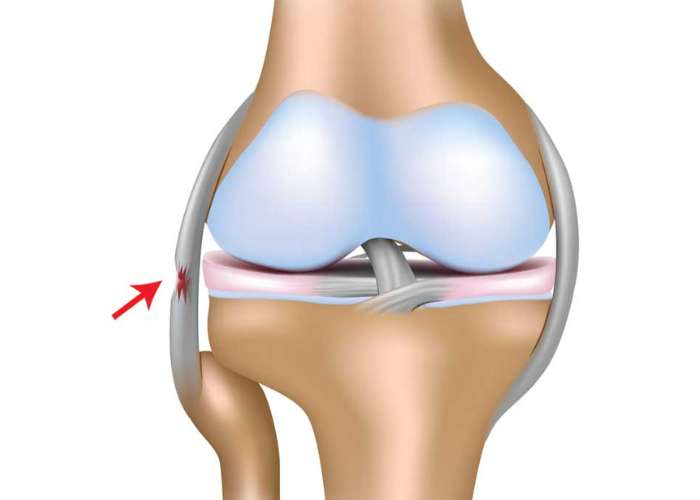LCL/FCL Injury Specialist
Do you have knee pain that’s getting worse? Is it hard to move and put weight on? You may have an LCL/FCL injury. LCL/FCL injury specialist Dr. Prem N. Ramkumar provides non-surgical and surgical treatments for patients with an LCL/FCL injury. His office is in Long Beach and serves Los Angeles, Orange County, and surrounding Southern California areas. Contact Dr. Ramkumar’s team for an appointment today!

What is an LCL Injury or (also called FCL injury)?
The lateral collateral ligament (LCL), also referred to as the fibular collateral ligament (FCL), is the main structure providing stability to the outside of the knee. The LCL/FCL complex connects the femur (thigh bone) to the fibula (small lower leg bone). The ligament allows you to rotate and move your knee from side to side. When an LCL/FCL injury occurs, knee stability is compromised. The LCL represents one of the main anatomic structures that embody the posterolateral corner/complex (PLC) of the knee, which includes the LCL, the popliteus tendon, and the popliteofibular ligament. Additionally, the lateral capsule (with its thickening called the anterolateral ligament) and the biceps femoris attachment to the fibular head serve as very important stabilizers. An injury to the PLC is usually caused by a great amount of force and often occurs with another injury, such as a tear to the anterior or posterior cruciate ligament. Nearly 75% of patients who have a PLC injury will have a concurrent cruciate ligament injury. It is also very important to assess the function of the common peroneal nerve because the nerve crosses the fibular head very close to these structures and can result in a foot drop (weakness or inability to dorsiflex/raise the ankle) or numbness to the top of the foot. Approximately 15-20% of patients may have injury to the common peroneal nerve injury with a posterolateral complex injury. Dr. Prem N. Ramkumar, LCL/FCL injury specialist, is located in Long Beach and serves Los Angeles, Orange County, and surrounding Southern California areas.

What causes an LCL/FCL Injury?
A direct hit or blow to the inside or back of the can cause an LCL/FCL injury. Athletes involved in violent collisions or sudden stops and turns can also stretch the ligament to the tearing point. Repeated stress on the LCL/FCL causes the ligament to lose elasticity, making it more prone to injury. LCL/FCL tears are not as common as MCL or ACL tears but often appear simultaneously.
What are the symptoms of an LCL/FCL injury?
The symptoms of an LCL/FCL injury are similar to other knee ligament injuries. They may include:
- Mild swelling and pain, especially on the outside of the knee
- Catching, popping, or locking sensations during movement
- Stiffness and decreased range of motion
- Feeling as if the knee will collapse or give way, especially with side-to-side movement
- Difficulty twisting, turning, and pivoting
- Foot drop consistent with a common peroneal nerve injury
How is an LCL/FCL injury diagnosed?
Dr. Ramkumar will take a medical history and ask about the events leading up to the injury. He’ll perform a physical examination and move the knee from side to side. Some important exam maneuvers he will perform include:
- Varus Stress Test – in full extension and at 30° of knee flexion
- Dial Test at 30° and 90° of knee flexion
- Posterolateral Drawer Test
- Reverse Pivot Shift Test
Dr. Ramkumar may also order an X-Ray and an MRI to check for injury to the LCL/PLC and other aspects of the knee. Posterior kneeling stress x-rays should also be obtained when there is a concern for concurrent PCL tears to determine the amount of any increase in posterior translation on the injured knee. Once Dr. Ramkumar diagnoses you with an LCL/FCL injury, he grades it from one to three.
- Grade I Injury: small partial tear with minimal instability
- Grade II Injury: partial tear with an endpoint to stressing
- Grade III Injury: complete tear with no good endpoint to stressing
How is an LCL/FCL injury treated?
Treatment of an LCL/FCL injury depends on the severity of the injury. Grade I and II injuries typically best respond to non-surgical treatment. Non-surgical treatments include:
- RICE – Rest, Ice, Compression, and Elevation
- NSAIDs – Non-steroidal anti-inflammatories to help with pain and swelling
- Knee Brace – For added support to prevent loading the outer aspect of the knee
- Physical therapy – To regain strength and range of motion
Surgery could be necessary to reconstruct the PLC if nonsurgical treatments do not offer pain relief and stability. Dr. Ramkumar may recommend one of two surgeries:
- LCL Repair – A repair is made when there is a complete LCL/FCL tear near the native insertion sites on the femur or tibia. This is less commonly recommended compared to reconstruction.
- LCL Reconstruction – The ligament is reconstructed using a tissue graft from the patient (autograft) or a donor (allograft). Dr. Ramkumar performs this stabilization procedure when the tear has not responded to rehabilitation.
Patients typically stay in the hospital overnight to observe postoperative nerve function and look for any early warning signs of problems. Depending on the procedure, recovery time can take up to 6 months. After surgery, you will wear a knee brace and spend several weeks on crutches. Physical therapy will help you regain strength and mobility in your knee.

